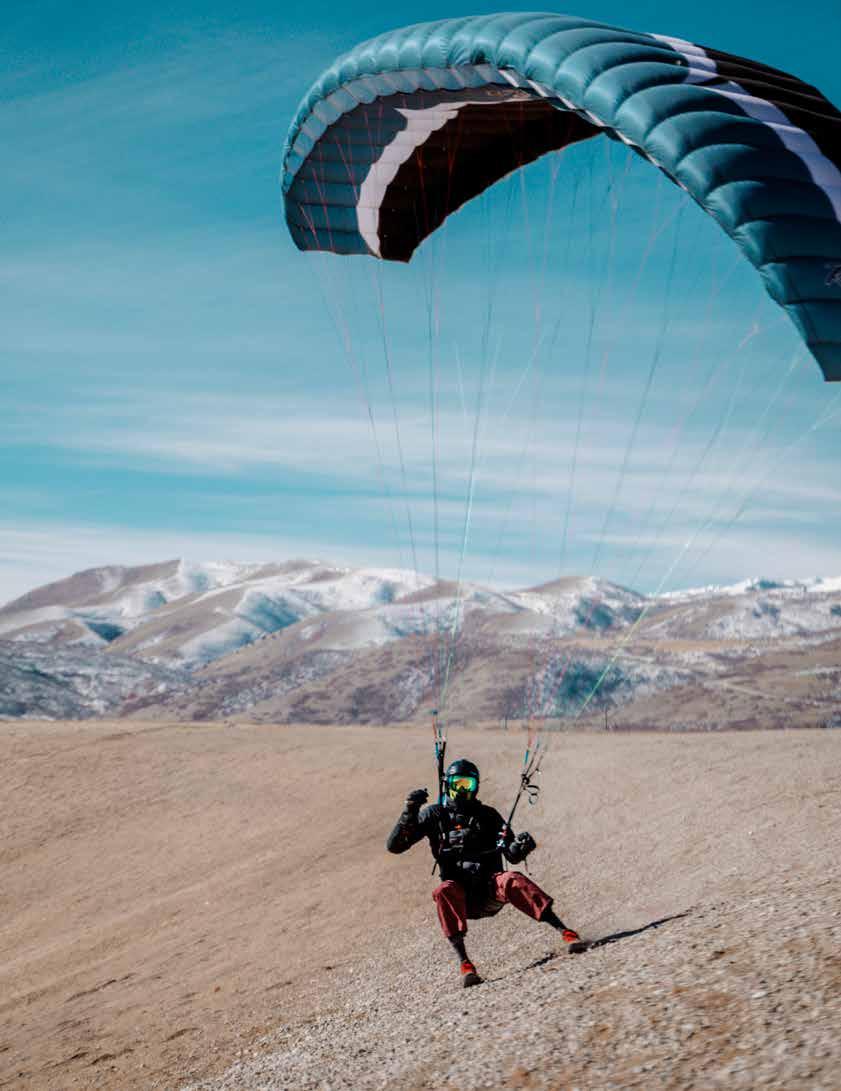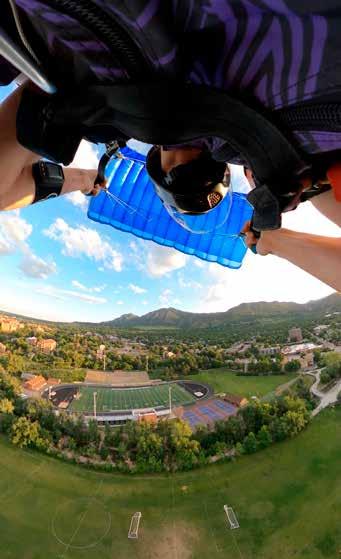
5 minute read
Skydiver Booby Traps
Skydiver
An addendum to speedflying instruction
by Carl Weiseth
:As speedflying continues to expand rapidly within the U.S., an increasing number of skydivers are transitioning into the free flight community with an interest in foot-launching speedwings. Although skydivers’ canopy experience may accelerate components of their learning curve when it comes to speedwings, it can also contribute to bad habits and overconfidence which have led to their regrettable reputation of being especially accident-prone.
Speedflying mentors and instructors seeking to help skydivers transition into free flight should exercise heightened vigilance and be prepared to combat overconfident decision-making and overly assertive toggle inputs. Using anecdotes and examples, instructors should highlight the differences between the two sports and encourage prior skydivers to view speedflying as a truly unique discipline, albeit under a visually similar canopy.
Below is a list of six common “booby traps” often encountered by skydivers progressing into speedflying—as well as some examples of appropriate corrections to offer on each topic.
1. Front riser inputs Skydivers (particularly “swoopers”) are often accustomed to pulling on their front risers to generate speed. On speedwings, this may result in frontal collapses with violent and unpredictable re-inflations. It is imperative to impart this knowledge early and often in prior skydivers’ speedflying progression. Make it clear to crossover students to never grasp the front risers while in flight on a speedwing. Speedwings are not designed for front riser input under any circumstances.
2. Swoop landings Skydivers often approach speedflying with some level of
Dante Wardlaw preparing his landing swoop. Carl Weiseth practices his South Side slide. Photo by Ian Rinefort. swooping experience, which can lead them, consciously or unconsciously, to presume that their speedwing will behave similarly to their smaller skydiving canopy. However, speedwings have very different dive and recovery arcs than skydiving canopies. The depth perception and muscle memory that a skydiver may have spent years assimilating on a skydiving canopy may prove misleading on a speedwing. Perhaps more specifically, the prior experience can prime skydivers learning to speedfly to come out too low on final turns into landing and subsequently pop up too high when providing over-eager brake inputs.

3.
Mechanical turbulence Given how and where most skydivers land (open fields), they often have little to no experience anticipating wind-rotor and mechanical turbulence caused by contours or obstacles in the landscape. When instructing on this point, it’s critical to stress how differently the flow of wind may affect a canopy over a three-dimensional landscape in a mountain environment instead of in a flat, two-dimensional drop-zone. Encourage skydivers to approach the instructional topics on wind and rotor with a beginner’s mindset, despite the fact they may have previous experience skydiving and landing in moderate headwinds.
4. Thermic conditions Most drop zones run jumps through the heat of the day, often amid even the most unstable, thermic afternoons. This can create a false sense of perceived safety in midday flying and an incomprehension of the danger that strong thermals present when flying a small canopy close to the landscape. With the exception of winter speedriding, it is almost always advisable to avoid midday speed flights—particularly on thermic, unstable days with direct sunshine. The windows of acceptable flying time (generally morning and evening) vary widely from site to site. Visiting or new speedwing pilots should consult with experienced local pilots before assuming it’s safe to fly after the sun has begun to warm the landscape.
5. Flying/landing on rear risers Many experienced skydivers are accustomed to piloting and landing their canopies using their rears or C’s. Comfort with piloting a skydiving canopy on rears should NOT translate to comfort piloting a speedwing on rears. Skydive canopies are much more docile and deflation-resistant—typically exhibiting significantly greater passive safety. Ozone has released a video providing a comprehensive summary of the appropriate perspectives for rear-riser flying on speedwings, easily found with a quick YouTube search.

6. Heavy-handed piloting Extensive experience skydiving can cause many new speedwing pilots to initially provide overly aggressive control inputs. This tendency stems from the lack of weight-shift sensitivity on most skydive harnesses and the greater pull-weights and significantly lesser brake-sensitivity of skydiving canopies. These aggressive inputs can result in stalling or spinning a speedwing or steep and dramatic turns back towards the hillside or the ground.
Comparable-sized speedwings are much more sensitive to weight shift and brake inputs than a skydiving
Skydiver Dante Wardlaw. Photos by Everett Schwartz.
canopy. This will necessitate deliberate work to retrain an experienced skydiver’s muscle memory over an extended period of time. That way, in moments of stress or panic, a skydiver’s reflexively heavy-handed muscle memory doesn’t accidentally spin or stall the wing. All turns should be initiated with weight shift and accompanied by smooth, tapered, and sparing brake inputs. This same tendency can also manifest as a cascade of repeating over-corrections in which a pilot constantly has to provide opposing inputs to counteract initially heavy-handed brake-pulls. Prior skydivers should practice initiating turns with weight-shift and providing the minimum amount of brake pressure needed to accomplish the desired directional change. Pilots should note if oscillations or directional changes exceed their initial intentions and attempt to scale back the pressure applied to brake toggles to match the desired trajectory without the need to counter-correct.
:As an increasing number of skydivers continue to bump over to speedflying, the broader free flight community must provide positive encouragement towards formal instruction—even for highly experienced skydivers accustomed to swooping tiny canopies. It’s also important that both formal instructors, as well as friends and mentors, continue to prioritize highlighting the differences between speedflying and skydive canopy piloting and nudge transitioning skydivers to exercise caution applying their previous knowledge base to this rapidly evolving new sport.
Carl Weiseth is the founder of Speedfly.com and has flown speedwings throughout the U.S. and internationally. He led the effort to define and develop the USHPA Speedflying Rating System and co-authored the accompanying speedflying-specific syllabus content for the U.S. It may potentially also be used for speedflying programs in Canada and other countries. He now resides in Utah at Point of the Mountain, where he teaches and promotes speedflying to the public.











